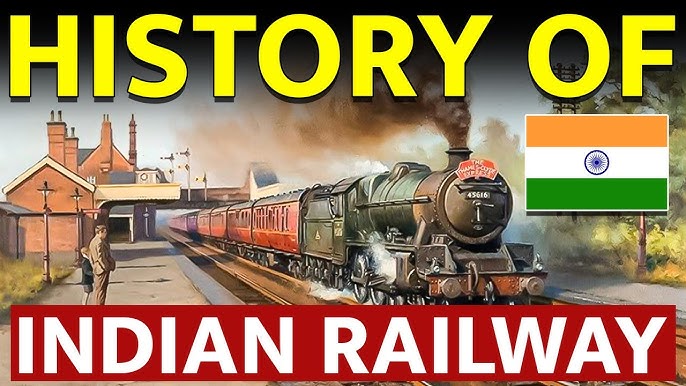Indian Railways is the fourth-largest network in the world, spanning over 1.2 Lakh Km across the country. Mainly, three kinds of services are provided by the Indian Railway to the public including Express trains, Mail Express, and Passenger Trains. If we talk about the fare, then Passenger trains fare are the lowest and Mail Express trains are the highest. On the other hand, Express trains fare lie in the middle.
Indian Railways is more than just a mode of transportation — it’s a backbone of the country’s growth. From connecting remote villages to bustling cities, trains have shaped India’s economy and society over the past 170 years. This article traces the journey of Indian Railways, highlighting key milestones, challenges, and what lies ahead.
The Beginning of Indian Railways (1853-1900)
Early Conception and Construction of Rail Lines
The first train in India chugged from Mumbai (then Bombay) to Thane on April 16, 1853. This historic run marked the start of India’s railway era. It covered about 21 miles and was pulled by three steam locomotives built in Britain. The success was swift, and soon, railway lines spread to other major cities like Kolkata and Chennai.
Leading companies like the Great Indian Peninsula Railway and East Indian Railway Company led these efforts. Their mission? To connect India’s key ports, resources, and administrative centers.
In 1832, the idea of setting up a railway system in British India was first proposed. At that time, rail travel was still in its infancy in Britain, but the East India Company knew the benefits of developing an extensive rail network. After a long decade of inaction, private entrepreneurs were allowed to establish a rail system by Lord Hardinge, the Governor-General of India in 1844. Two companies were formed by the year 1845 namely “East Indian railway Company” and the “Great Indian Peninsula Railway”.
Technological and Infrastructure Developments
Steam engines powered the initial trains, transforming travel and trade. Early workshops in colonies built locomotives, carriages, and rails. Building through rugged terrains like the Western Ghats posed tough challenges but also pushed engineering innovations.
Impact of Colonial Policies on Railway Growth
The British wanted railways to serve their economic interests. Rail lines helped export raw materials like cotton, tea, and minerals. They also moved troops quickly across India—sometimes to suppress rebellions. The railways expanded largely to benefit colonial powers, often at the expense of local needs.
The Post-Independence Era and Nationalization (1947-1980)
Transition from Colonial to National Ownership
When India gained independence in 1947, the railway system needed a fresh start. The government took steps to unify and expand the network. By 1951, Indian Railways became an integral, government-run entity. Over time, it was split into regional zones for easier management.
Expansion and Modernization Initiatives
The 1950s and 60s saw new types of trains—diesel and electric engines replaced steam. New tracks connected remote areas and boosted economic growth. The creation of zones like Northern, Southern, and Eastern Railways helped improve service.
Significance in India’s Socio-Economic Development
Trains helped unify India—bringing farmers to markets and workers to industries. They became vital for moving goods and people, fueling economic progress and social integration across the country.
Technological Advances and Modernization (1980-2000)
Introduction of Computers and Signaling Technologies
Technology changed how Indian Railways worked. Computerized systems were introduced for signaling and operations. The official reservation system, IRCTC, made booking easier for millions, replacing long queues and manual tickets.
Innovations in Passenger Comfort and Safety
The 1990s launched fancy trains like the Rajdhani and Shatabdi Express—fast, comfortable, and safe. Stations improved with better platforms and amenities. Coaches got air conditioning, better seats, and modern toilets.
Challenges Faced
Despite progress, older systems faced congestion, safety problems, and funding shortages. Accidents from outdated infrastructure still occurred and needed urgent attention.
The 21st Century: Railways as a Catalyst for Modern India
High-Speed Rail and Major Projects
The Mumbai-Ahmedabad Bullet Train project sparks excitement nationwide. It aims to cut travel time from 15 hours to just a few hours. Many cities now see metro systems, making urban commutes smoother.
Digital Transformation and Sustainability Initiatives
Ticket bookings moved online, with mobile apps and contactless payments. Stations are becoming eco-friendly with solar panels and energy-efficient lighting. These steps reduce the carbon footprint of Indian Railways.
Expansion of Freight and Logistics Capabilities
Cargo services grew to boost India’s manufacturing sector. Railways now focus on moving more goods efficiently, supporting “Make in India” and increasing exports.
Future Outlook and Challenges
Vision for a Modern, Sustainable Railway Network
The goal? Smart stations with digital screens, automation, and comfortable services. AI and IoT will help predict train delays and maintenance needs, making travel smooth.
Sustainability and Environmental Goals
Indian Railways aims to cut pollution, using renewable energy sources like wind and solar. Expect eco-friendly stations and greener trains in upcoming years.
Ongoing Challenges
Funding remains tight, making it hard to modernize fully. Safety issues, like accidents, still need better solutions. Balancing modernization with affordability for millions is crucial.
Conclusion
Indian Railways has come a long way—from its humble start in 1853 to a sprawling network today. It’s a vital part of India’s economy, society, and identity. The future promises more innovation, greener practices, and smarter services. Staying committed to these changes will keep Indian Railways humming forward for generations to come.

